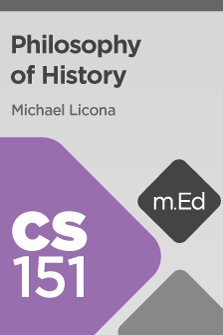New Testament: Advanced Background and Context Studies Study Bundle
Digital Logos Edition
Overview
In the New Testament: Advanced Background and Context Studies Study Bundle you’ll study cultural background of first-century Israel. You will explore biblical archaeology in the field and see how it sheds light on the world of Jesus. You’ll learn about important Jewish writings from the Second Temple Period and see how they influenced the thought of the New Testament writers. You will discover the relevance of concepts like hospitality, family, purity, patronage, honor, and shame in the cultural world of the New Testament. These courses provide important insight into the culture of the New Testament.
This title is included in the following collections
You can save when you purchase this product as part of a collection.
Mobile Ed: Master Collection (...
$31,999.99$31,999.99

- Title: New Testament: Advanced Background and Context Studies Study Bundle
- Publisher: Lexham Press
- Product Type: Logos Mobile Education
- Resource Type: Courseware, including transcripts, audio, and video resources
- Courses: 13
- Video Hours: 34
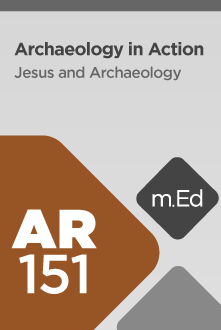
Join distinguished professor Dr. Craig A. Evans on a journey to some of the most significant New Testament archaeological sites. Filmed on-site in Israel’s Galilee region, Dead Sea region, and Jerusalem, this course will give you insight into first-century socioeconomic life and will help you grasp the historical and biblical context of Jesus’ ministry.
As the course takes you through cities and other locations around the Sea of Galilee, you’ll learn where Jesus and his disciples walked and lived, including Capernaum, the headquarters of Jesus’ Galilean ministry. Discover how the Qumran Dead Sea Scrolls reveal how deeply rooted in the Old Testament the early Christian movement was, and hear how these texts have been preserved for future generations. Explore burial practices and evidence of crucifixion in the first century in Jerusalem.
Contents:
Unit 1: Galilee and the Surrounding Areas
- Nazareth
- Capernaum: Synagogue and Peter’s House
- Bethsaida
- Magdala: Village and Synagogue
- Magdala: Boat
- Caesarea Maritima
Unit 2: Dead Sea Region
- Masada and the Dead Sea
- The Essenes and the Dead Sea Scrolls
- Messianic Expectation at Qumran
- Damascus Document and the Serek Scroll
Unit 3: Jerusalem
- Discoveries in and around Jerusalem
- Hezekiah’s Tunnel and the Pool of Siloam
- The Jerusalem Temple and Evidence for the Crucifixion
- Roman Crucifixion and Jewish Burial Practices
- X-Shaped versus T-Shaped Cross Theories
- Jehohanan’s Heel Bone: Part 1
- Jehohanan’s Heel Bone: Part 2
- Jesus’ Cross
- Jewish Burial Practices at the Tombs of Aceldama
- The Shroud Tomb and Jesus’ Burial
- Jesus’ Burial and Resurrection
 Dr. Craig A. Evans received his PhD in New Testament from Claremont Graduate University and his DHabil from the Karoli Gaspar Reformed University in Budapest. He is the John Bisagno Distinguished Professor of Christian Origins at Houston Baptist University in Texas.
Dr. Craig A. Evans received his PhD in New Testament from Claremont Graduate University and his DHabil from the Karoli Gaspar Reformed University in Budapest. He is the John Bisagno Distinguished Professor of Christian Origins at Houston Baptist University in Texas.
Evans taught at Trinity Western University in British Columbia for 21 years, where he directed the graduate program in biblical studies and founded the Dead Sea Scrolls Institute. He has recently served on the advisory board for the Gospel of Judas for National Geographic Society and has appeared frequently as an expert commentator on network television programs.
Evans has written and edited extensively on the historical Jesus and the Jewish background of the New Testament era. His published works include From Prophecy to Testament: The Function of the Old Testament in the New , Jesus and the Ossuaries, Jesus: The Final Days, and Dictionary of New Testament Background.
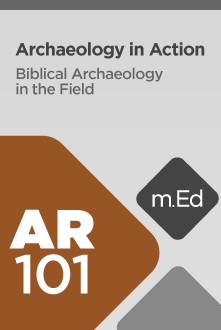
Explore archaeological digs in Israel by joining distinguished scholars in the field, who will teach you the processes and practices of biblical field archaeology. Learn the tools and techniques used by archaeologists and volunteers to find relics buried for millennia. Discover the passion of those who have invested their lives into uncovering and studying material culture. Watch as they unearth objects for the first time after thousands of years.
In this course, filmed on site in Israel, you’ll experience the process of a dig and hear directly from archaeologists. Their findings shed light on what life was like in the first century world of Jesus and the apostles.
“We’re going to start with the ground, dig into it, find things, and take you all the way from the point it begins to the point where it is exhibited in museums and written about in textbooks. Come on. Join me. You’re going to have a lot of fun doing this.”
— Craig Evans
Contents:
List of Archaeologists and Professors:
- Dr. Adolfo Roitman, The Israel Museum, Jerusalem
- Dr. Jodi Magness, University of North Carolina at Chapel Hill
- Dr. Craig Evans, Houston Baptist University
- Dr. Richard Freund, University of Hartford
- Dr. Rami Arav, University of Nebraska Omaha
- Dr. Scott Stripling, Wharton County Junior College
- Dr. Mordechai Aviam, Kinneret College on the Sea of Galilee
- Dr. David Fiensy, Kentucky Christian University
- Dr. Dennis Groh, Illinois Wesleyan University
- Dr. James F. Strange, University of South Florida
- Dr. James R. Strange, Samford University
- Dr. Itzhaq Shai, Ariel University
- Chris McKinny, Bar-Ilan University
- Sheila Gyllenberg, Bar-Ilan University
Unit 1: Introduction to Archaeology
- What Is Archaeology?
- How Archaeology Is Informed by Biblical and Ancient Literature
- Studying Texts vs. Studying Material Culture
Unit 2: The Archaeological Dig Process
- Research and Preparation
- Field Work and Processing Archaeological Finds
- Publication
Unit 3: Roles and Jobs at a Dig Site
- Volunteering at a Dig Site
- Daily Life at a Dig Site
- Responsibilities of the Dig Directors and Supervisors
- Becoming an Archaeologist
Unit 4: Anatomy of a Dig Site
- Squares
- Balks and Stratigraphy
- Importance of a Sealed Locus for Stratigraphy
- Importance of Determining Location within a Tel
Unit 5: Archaeological Dig Techniques
- Use of Archaeological Hand Tools within a Square
- Sifting of Selected Sealed Contexts
- Metal Detection Methods
- Advanced Geophysical Survey Methods
- Record Keeping
Unit 6: Pottery Techniques
- Excavating Pottery
- Oil Lamp Analysis
- Neutron Activation Analysis
- Reconstruction of Pottery Vessels
Unit 7: Profile of Dig Sites and Material Culture Discoveries
- Huqoq’s Galilean Type Synagogue
- The Rediscovery of Bethsaida
- Material Culture at Bethsaida
- Khirbet el-Maqatir: Background
- Material Culture at Khirbet el-Maqatir
- Scarab and Ancient Diagram at Khirbet el-Maqatir
- Tel Burna: Background
- The Historical Importance of Shikhin
- Shikhin’s Pottery Manufacture
- Life in First-Century Galilee
- The Historical Importance of Sepphoris
Unit 8: Curation and Presentation
- Preservation and Curation of Artifacts
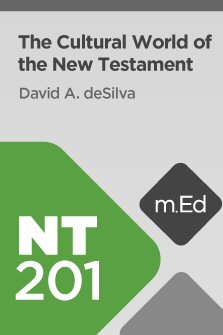
Join Dr. David deSilva as he describes important cultural concepts from the first century and shows how these concepts shed light on the New Testament. Learn why the author of 1 Peter spoke to the shame Christians were experiencing, and what cultural norms they had to fight against as they sought to follow Christ. Discover how grace and gratitude were viewed differently than they are today. Learn what purity meant for Jews, how patronage and reciprocity impacted everyday decisions, how families and households operated, and more. Dr. deSilva pulls from a variety of sources to explain these concepts and uses the books of Hebrews and 1 Peter to illustrate them.
This course will give you a better understanding of the environment early Christians were in as they broke the rules of society for the sake of the gospel.
Contents:
Introduction
- Introducing the Speaker and the Course
Unit 1: Honor and Shame
- Introduction to Culture
- Honor, Shame, and Social Control
- Honor and Shame in Complex Cultures
- Competing for Honor
Unit 2: Honor and Shame: 1 Peter
- The Experience of Shame
- Consider the Source
- Who’s on Trial Here?
- Reinterpreting Experiences of Shame (Part 1)
- Reinterpreting Experiences of Shame (Part 2)
- Defending Your Honor
- Using a Historical Background Collection
- Honored in God’s Sight
- The Social Matrix of Perseverance
- Embodying 1 Peter
Unit 3: Patronage and Reciprocity
- Patrons, Clients, and Brokers
- The Social Context of Grace
- Running a Louw-Nida Search on Charis
- Graceful Giving
- Graceful Receiving and Expression of Gratitude
- An Example from the Life of Jesus
Unit 4: Patronage and Reciprocity: Hebrews
- God as Patron
- Jesus as Patron and Mediator
- The Letter to the Hebrews and Its Audience
- Summons to Grateful Response
- Warnings against Ingratitude (Part 1)
- Warnings against Ingratitude (Part 2)
- Cultural Awareness and Solving Theological Problems
Unit 5: Family and Household
- Establishing Kinship
- Kinship Ethics
- The Household of the Classical World
- Women in the Household
- Studying Sirach on the Silent Wife
- Children
- Analyzing Parentage and Honor (John 8:31–41)
- Slaves
- Reconfiguring Kinship
- Searching for the Cultural Concept of Kinship
Unit 6: Family and Household: 1 Peter
- New Birth into a New Family
- Ethical Implications of the New Birth
- Advice for Christians in Natural Households: Wives
- Advice for Christians in Natural Households: Husbands
- Advice for Christians in Natural Households: Slaves
Unit 7: Purity and Pollution
- Basic Concepts
- Clean, Unclean, Common, and Holy
- Early Judaism’s Purity Maps (Part 1)
- Investigating Herod's Temple
- Early Judaism’s Purity Maps (Part 2)
- What Makes Purity Codes Meaningful?
- Levels of Concern for Purity
Unit 8: Purity and Pollution: Hebrews
- Purity Regulations in a Pauline Church
- Purity and New Group Boundaries
- Rewriting Maps of Sacred Space and Personnel
- Jesus’ Death as Consecration
- Reexamining Purity Lines Today
- Building a Sermon on Defilement (Mark 7:20–23)
Conclusion
- Authentic Hearing, Authentic Following
 Dr. David A. deSilva is the trustees’ distinguished professor of New Testament and Greek at Ashland Theological Seminary in Ohio, where he’s taught since 1995. He’s written over 20 books in the areas of New Testament and Second Temple Judaism and is a leading expert on the cultural world of the New Testament.
Dr. David A. deSilva is the trustees’ distinguished professor of New Testament and Greek at Ashland Theological Seminary in Ohio, where he’s taught since 1995. He’s written over 20 books in the areas of New Testament and Second Temple Judaism and is a leading expert on the cultural world of the New Testament.
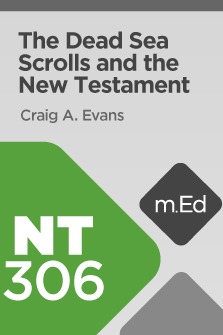
Craig Evans combines his extensive knowledge of ancient manuscripts and New Testament studies to survey the contents, context, and influence of the Dead Sea Scrolls. He details the history of the scrolls and the Essenes, and shows how the scrolls affect our understanding of Jesus, John the Baptist, and the early church.
Contents:
Unit 1: Introduction and Overview
- Introducing the Speaker and the Course
- Overview of the Course
- Creating a Layout for the Biblical Dead Sea Scrolls
- The First Discovery
- Important Genizah Finds
- The Second Find
- Scripture Scrolls
- Pesharim: Commentary Scrolls
- Militant Messianic Pesharim
- Adding the Sectarian Dead Sea Scrolls to the Dead Sea Scrolls Layout
- Sectarian Scrolls
- The Essenes and the Origins of the Scrolls
- Building and Searching a Collection of Dead Sea Scrolls Resources
- What the Ruins Tell Us
Unit 2: Dead Sea Scrolls: Gospels
- John the Baptist: Part 1
- John the Baptist: Part 2
- Jesus and the Dead Sea Scrolls
- Jesus’ Proclamation of Jubilee
- Jesus’ Exorcism and Healing
- Exorcism and the Psalms
- Strings of Beatitudes
- Jesus’ Assurance for John the Baptist
- Jesus on Divorce and Monogamy
- Qumran on Divorce and Monogamy
- Researching the Essenes’ Belief about Divorce
- The Temple Tax
- The Eschatological Banquet
- God’s Vineyard
- The Law and Life
- Conclusions: Value of the Dead Sea Scrolls
Unit 3: Dead Sea Scrolls: Epistles and Revelation
- Paul and Qumran: Ecclesiastical Terminology
- Paul and Qumran: “Works of the Law”
- James versus Priestly Zeal for the Law
- Qumran and “Works of the Law”
- The Sons of Light
- Mystery and Revelations
- The Flesh and Spirit
- Covered Heads and Angels
- Order in the Assembly
- James and Doing the Law/Word
- Hebrews on Melchizedek
- Qumran on Melchizedek
- Spiritual Sacrifice
- Qumran and John: Dualism
- Qumran and John: Conceptual Parallels
- Revelation on New Jerusalem
- Qumran on New Jerusalem
- New Jerusalem: Summary
- Use of the Scrolls for New Testament Interpretation
- Postscript: Possible Early Discoveries
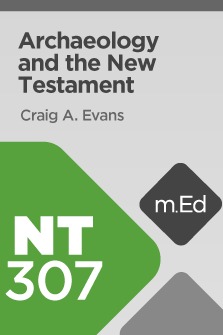
In this course, Craig Evans describes the world of Jesus and the early church based on archeology. He draws connections between archaeological finds and relevant Scripture passages and theological issues. Evans discusses how archaeology sheds light on the synagogues of Israel, literacy of the time, Pilate and Caiaphas, and burial traditions.
Contents:
Introduction
- Introducing the Speaker and the Course
Unit 1: The Tasks of Archaeology
- Recovery of Material Culture
- Studying Archaeology with The Archaeological Encyclopedia of the Holy Land
- Related Disciplines
- Contribution of Science
- Spectrometrical Analysis: An Example of Science Aiding Archaeology
- Other Enhancements and Analyses
- Important Excavation Sites
- Preview of Remaining Course Topics
Unit 2: Jesus and the Synagogues
- Jesus Visited the Synagogues
- Searching for Synagogue References in the New Testament
- But Were There Synagogues?
- The Capernaum Synagogue
- Have We Found Peter’s House?
- Gamla
- The Herodium
- Jericho
- Studying Jericho with Image Searching and the Bible Facts Report
- Jerusalem
- Magdala
- Masada
- Modi’in and Qiryat Sefer
- Nazareth and Sepphoris
- Researching the Theory that Jesus Was a Jewish Cynic
Unit 3: Books and Artifacts
- Book Culture and Literacy
- The Suffering Servant and Jesus
- Researching New Testament Quotes or Allusions to Isaiah
- The Qumran Scroll and the Leningrad Codex
- The Aramaic Targums
Unit 4: Pilate and Caiaphas
- The Caiaphas Ossuary
- Other High Priests and Miriam
- Finding and Exporting Images of Ossuaries
- Pontius Pilate
- Finding Pilate in the Writings of Josephus and Philo
- Procurator or Prefect?
Unit 5: Jewish Tombs and Burial Traditions
- The Importance of the Archaeology of Burial
- Jewish Burial Practices: Burial and Funeral
- Jewish Burial Practices: Ossilegium
- The Soul Departs Three Days after Death
- Resources for Studying Ancient Cultural Backgrounds
Unit 6: Jesus’ Death and Burial Compared with Jewish Burial Traditions
- Why Such Large Crowds Followed Jesus
- Whitewashed Tombs
- Let the Dead Bury Their Own Dead
- Researching Matthew 8:22 with the Passage Guide
- Lazarus
- Jesus is Anointed with Perfume
- Two Sites Are Claimed to Be Jesus’ Burial Place
- Studying Joseph of Arimathea with Bible Facts
- Jewish Piety Required Burial
- Did Pilate Permit the Burial of Jesus?
- Burial Restrictions for Executed Criminals
- The Death and Burial of Jesus
- The Talpiot Tomb Prompts Speculation
- Solving the Mystery of the Gable
- More Conclusions Concerning the Talpiot Tomb
Conclusion
- Summing Up the Course
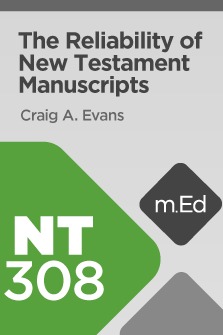
In this course, Craig Evans answers a question commonly asked about the New Testament—can we trust the manuscripts? Because the answer has serious consequences, Dr. Evans clearly outlines the history of these important documents. He discusses the quality, quantity, and age of the manuscripts and how these elements compare to nonbiblical ancient texts. Numerous text examples as well as descriptions of the practices of ancient writers and scribes also contribute to his argument for reliable manuscripts.
Contents:
Introduction
- Introducing the Speaker and the Course
Unit 1: Evidence for the Reliability of New Testament Manuscripts
- The Basics of New Testament Manuscripts
- Finding Manuscripts in Logos
- Examples Demonstrating the Quality of New Testament Manuscripts
- Adding Manuscript Images to Presentations or Documents
- Exploring Ancient Manuscripts and Resources
- The Comparative Strength of the New Testament Manuscript Record
- The Longevity of the Autographs
- Researching the Works of Tertullian
- The Number of Autographs
- Accessing and Navigating the Textual Apparatus
- The Preservation of the New Testament in Translations
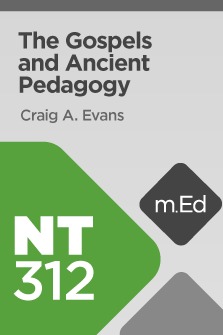
The Gospels are 2000-year-old texts, so as you read them it is important to understand the ancient genre they represent. In this course, Craig Evans surveys the Gospels, discusses issues of text criticism, and explains ancient teaching methods so you understand not only what Jesus taught, but how he taught it and why his lessons are recorded as they are across the Gospel texts.
Contents:
Introduction
- Introducing the Speaker and the Course
Unit 1: Gospels: Chronology, Canonicity and Text
- Gospel of Mark
- Researching the Dating of Mark’s Gospel with Custom Collections
- Gospel of Matthew
- Surveying the Jewish Temples with Bible Facts and the Timeline
- Gospel of Luke
- Examining the Greek Word behind Paul and Barnabas’ “Sharp Disagreement”
- Gospel of John
- Examining the Identity of the “Beloved Disciple”
- Early Canonicity and Stable Text
Unit 2: Gospels: Jewish Versions
- A Hebrew Matthew?
- Hebrew Matthew: Two Approaches
- Shem Tov’s Hebrew Matthew: Part 1
- Finding the Frequency of “God” in the Gospels
- Shem Tov’s Hebrew Matthew: Part 2
- Shem Tov’s Hebrew Matthew: Part 3
- Using the Sermon Starter Guide to Research the Kingdom of God
- Shem Tov’s Hebrew Matthew: Part 4
- Patristic Evidence of a Hebrew Matthew
- Ways of Citing Jewish Gospels
- Origen: Gospel of the Nazarenes
- Epiphanius: Gospel of the Ebionites
- Jerome: Gospel of the Nazarenes
Unit 3: Historiography and Pedagogy
- Introducing Historiography and Pedagogy
- Historiography: Truthful but Not Verbatim
- Pedagogy: Memorization but Not Verbatim
- Researching Differences in the Gospels
Unit 4: The Synoptic Problem
- Introducing the Synoptic Problem
- Examples of the Synoptic Differences
- Synoptic Case Study: Stilling the Storm
Conclusion
- Summary Observations
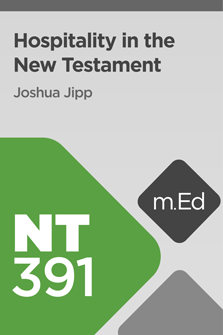
What does hospitality look like for the authors of the New Testament? Dr. Joshua Jipp presents the biblical concept of hospitality through a thorough examination of the relevant literature in Luke-Acts, the Gospel of John, and the Pauline Letters. The course begins by exploring the ancient background of hospitality as practiced in the Graeco-Roman world and ancient Israel. Dr. Jipp pays particular attention to Jesus because the hospitality that he practiced, as both guest and host, became the exemplar for the apostles and the early church, and should be the model that the church exhibits today. Jipp’s masterful study of a common, yet understudied, theme in the New Testament is highly organized, exegetically sound, and theologically stimulating, thus giving this course great potential for application in the local church and beyond.
Contents:
Introduction
- Introducing the Speaker and the Course
- Defining Hospitality
Unit 1: The Historical Context of Hospitality
- Introduction to Background Texts
- Homer’s Odyssey
- Dio Chrysostom’s The Hunter
- Ovid’s Metamorphoses
- Synthesis of Graeco-Roman Sources
- Hospitality in the Old Testament
- Abraham’s Hospitality
- The Hospitality of Lot and the Sodomites
- The Immigrant Patriarchs
- Hospitality in the Torah
- Summary Thoughts
Unit 2: Hospitality in Luke’s Gospel
- Overview of Hospitality in Luke
- Review of Divine Visitations
- Jesus, the Agent of God’s Visitation
- Jesus, the Journeying Stranger
- Responding to Jesus: Simon and the Sinful Woman
- Responding to Jesus: A Samaritan Village
- Responding to Jesus: Galilean Households
- Responding to Jesus: The Pharisees
- Responding to Jesus: Mary and Martha
- Responding to Jesus: Zacchaeus
- Jesus, the Divine Host
- Hosting the Eschatological Banquet
- The Messiah’s Food
- Proclaiming Yahweh’s Welcome
- Feeding the Multitudes
- Eating with Sinners
- Sharing the Last Supper
- The Guest Becomes Host
- Summary: Jesus as Host in Luke’s Gospel
- The Ethics of Jesus’ Hospitality
- Jesus’ Agents and Emissaries
- Being a Neighbor
- Eating Bread in God’s Kingdom
- True Sons of Abraham
- The Economies of Two Kingdoms
Unit 3: Hospitality in Acts
- Overview of Hospitality in Acts
- Extending Christ’s Table
- The Meals of the Early Church
- The Inclusion of the Gentiles
- Creating a Sacred Household
- The Conclusion of Acts
- Concluding Comments on Luke-Acts
Unit 4: Hospitality in John’s Gospel
- Overview of Hospitality in John’s Gospel
- Divine Revelation and Human Recognition
- Jesus as a Heavenly Stranger
- Providing New Covenant Wine
- Providing Living Water
- Providing Bread of Life
- The Foot Washing
Unit 5: Hospitality in Paul
- Overview of Hospitality in Paul’s Letters
- Meals in Corinth
- Celebrating Jesus’ Hospitality
- Implementing Jesus’ Hospitality
- Hospitality in Paul’s Mission
- Hospitality in Romans
- The Roman Church’s Hospitality
- Unity and Creating Kinship
Conclusion
- Concluding Comments
 Dr. Joshua Jipp has taught New Testament in a variety of settings, including as a teaching fellow at TEDS, before joining the faculty at Trinity Evangelical Divinity School. He enjoys baseball, basketball, hiking outdoors, and spending time with his wife, Amber, and their two sons. His most recent scholarly work includes Paul’s Areopagus Speech of Acts 17:16–34 as Both Critique and Propaganda in theJournal of Biblical Literature, and Divine Visitations and Hospitality to Strangers in Luke–Acts: An Interpretation of the Malta Episode in Acts 28:1–10 (Brill). He’s currently working on a book on Pauline Christology for Fortress Press and the Two Horizons Commentary on the Acts of the Apostles for Eerdmans.
Dr. Joshua Jipp has taught New Testament in a variety of settings, including as a teaching fellow at TEDS, before joining the faculty at Trinity Evangelical Divinity School. He enjoys baseball, basketball, hiking outdoors, and spending time with his wife, Amber, and their two sons. His most recent scholarly work includes Paul’s Areopagus Speech of Acts 17:16–34 as Both Critique and Propaganda in theJournal of Biblical Literature, and Divine Visitations and Hospitality to Strangers in Luke–Acts: An Interpretation of the Malta Episode in Acts 28:1–10 (Brill). He’s currently working on a book on Pauline Christology for Fortress Press and the Two Horizons Commentary on the Acts of the Apostles for Eerdmans.
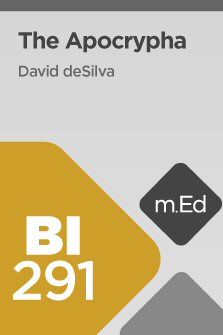
In this course, distinguished scholar Dr. David deSilva provides you with an introduction to the Old Testament Apocrypha. Become familiar with the setting and content of books such as 1–4 Maccabees, Judith, Baruch, the Wisdom of Solomon, and more. Understand how these writings influenced the writers of the New Testament and the early church, and how they provide us with valuable insight into the Judaism of the time of Christ.
Contents:
- The Apocrypha: A General Introduction
- The Books of the Apocrypha: 1 Esdras and the Wisdom of Ben Sira
- The Books of the Apocrypha: 1 and 2 Maccabees
- The Books of the Apocrypha: Judith and 2 Esdras
- The Books of the Apocrypha: Tobit, Susanna, and Baruch
- The Books of the Apocrypha: Letter of Jeremiah, Bel and the Dragon, Wisdom of Solomon, and Greek Esther
- The Books of the Apocrypha: 3 and 4 Maccabees
- The Books of the Apocrypha: Prayer of Manasseh, Psalm 151, and More Additions to Daniel
- Sketches of the Impact of the Apocrypha
- The Apocrypha in the Christian Church and Canon
Philosophy of History (CS151) establishes a theory of history and then applies it to a historical investigation of the resurrection of Jesus. It provides an extensive and detailed consideration of the many issues related to historical investigation—including the uncertainty of historical knowledge, the influence of one’s worldview in historiography, the historian’s right to investigate miracle claims, burden of proof, and arguments to the best explanation.
The course then walks through this strictly-controlled historical method to investigate the historicity of the resurrection of Jesus. You’ll learn the relevant biblical and non-biblical sources which are identified and evaluated according to their historical reliability. Finally, the course weighs two prominent hypotheses that account for the historical bedrock according to the historical method set forth above. The bodily resurrection of Jesus is shown to be a near-certain historical probability, and thus, a solid basis for one’s faith in God—a faith that produces an eternal hope in the resurrection life.
Contents:
Introduction
- Introducing the Speaker and the Course
Unit 1: Theory of History
- Second-Guessing and the Challenge of History
- Defining Terms and Challenges to Knowing the Past: Part 1
- Challenges to Knowing the Past: Part 2
- Transcending Horizons
- The Role of a Consensus
- The Uncertainty of Historical Knowledge
- Postmodernist History
- Problems with Postmodernist History
- Three Views of History, Historical Facts, and Burden of Proof
- Theory and Historians
- What Historians Do
Unit 2: Method to History
- Arguments to the Best Explanation
- Arguments from Statistical Inferences
- Criteria of Authenticity
- Application of the Criteria of Authenticity to the Historical Jesus
Unit 3: Miracles and the Historian
- Defining Miracles
- David Hume and the Impossibility of Miracles
- The Principle of Analogy and Philosophical Assumptions
- Bart Ehrman and the Reliability of the Gospels
- Contradictions
- Most Probable Explanation
- James D. G. Dunn, the Interpretation of Data, and Burden of Proof
- Preponderance of Evidence and a Turning Point for Historians
Unit 4: Historical Sources and the Resurrection of Jesus
- Relevant Sources
- Canonical Gospels
- Matthew’s and Luke’s Use of Mark
- Reliability of the Gospels and the Letters of Paul
- Q and Speeches in Antiquity
- Speeches in Acts and Oral Formulas in Paul
- Origin and Reliability of the Oral Tradition in 1 Corinthians 15:3–7
- Josephus
- Tacitus, Mara bar Serapion, and Thallus
- Lucian, Celsus, Babylonian Talmud, and the Apostolic Fathers
- Gospel of Thomas
- Gospel of Peter, Gospel of Judas, Revelation Dialogues, and Pseudo Mark
Unit 5: Historical Bedrock Pertaining to Jesus’ Fate
- Jesus’ Life and Death
- Jesus’ Death by Crucifixion
- Appearances to the Disciples
- Three-Day Motif and the Nature of the Appearances: Part 1
- Legitimization of Authority and Nature of the Appearances: Part 2
- Gospel of Mark and Resurrection Appearances
- Appearances to Women, the Emmaus Disciples, and the Doubters
- The Apostles’ Testimony and Appearance to Paul: Part 1
- The Fate of Paul and Appearance to Paul: Part 2
- Paul’s View of the Resurrection: Part 1
- Paul’s View of the Resurrection: Part 2
- Paul’s View of the Resurrection: Part 3
- Appearance to James
- The Empty Tomb and Historical Bedrock
- B-Grade Facts
Unit 6: Weighing Hypotheses
- Michael Goulder’s Hallucination Hypothesis
- Analysis and Concerns of Goulder’s Hypothesis
- Marian Apparitions and Weighing Goulder’s Hypothesis
- Resurrection Hypothesis
- Evidence for a Supernatural Element in Reality
- Concluding Thoughts
Conclusion
- Summary of the Course
Dr. Licona was interviewed for Lee Strobel’s book The Case for the Real Jesus and he appeared in Strobel’s video The Case for Christ. He is the author of numerous books, including The Resurrection of Jesus: A New Historiographical Approach and Paul Meets Muhammad: A Christian-Muslim Debate on the Resurrection, coauthor with Gary Habermas of the award-winning book The Case for the Resurrection of Jesus, and coeditor of Evidence for God: 50 Arguments for Faith from the Bible, History, Philosophy, and Science. His next book will concern ancient compositional devices resulting in discrepancies in the Gospels and Plutarch’s Lives. Dr. Licona is a member of the Society of Biblical Literature, the Institute for Biblical Research, the Evangelical Theological Society, and the Evangelical Philosophical Society. He has spoken on more than seventy university campuses and has appeared on dozens of radio and television programs.
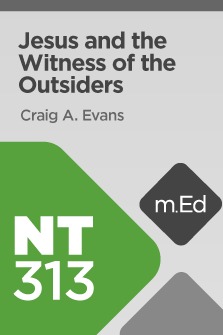
Evans’ study of the historical Jesus has led him to seek out a wide variety of ancient sources related to Christ. This course is a result of that study, focusing on the evidence from extrabiblical sources and seeing what they reveal about the life of Christ. Examine works by Roman and Jewish writers, and even invocations of Jesus’ name in pagan incantations, and discover what these works can tell us about Christ’s place in history.
Contents:
Introduction
- Introducing the Speaker and the Course
Unit 1: The Witness of Roman Writers
- Tacitus and Suetonius
- Pliny the Younger
- Celsus and Lucian
- Using Clippings to Document Ancient Non-Christian Witnesses to Christ
- Mara bar Serapion
Unit 2: The Witness of Jewish Writers
- Josephus’ Jewish Antiquities
- Using Timelines in Logos to Find Events in Jesus’ Life
- Translations of Josephus and Rabbinic Literature
- The Qur’an and Other Writings
- Building and Searching a Collection of Ancient Non-Christian Witnesses to Christ
Unit 3: Invocations of the Name of Jesus
- The Greek Magical Papyrus
- Silver Phylactery from Beirut
- Magic Bowls
- Curse Tablets and Lamellae
- The “Jesus Cup”
Conclusion
- Relevance of These Witnesses
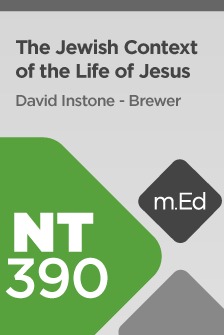
Explore the words of Jesus through the context of His conversations with other Jews. From the role of ancient rabbis and rabbinic literature to portrayals of Jesus in the Talmud, Dr. Instone-Brewer reveals how Jesus’ teachings were influenced by His Jewish life. We see Jesus attending the Jewish festivals, interacting with the Jewish leaders and laypeople and teaching them about the Father that He came from, was representing, and was going back to.
Contents:
Introduction
- Introducing the Speaker and the Course
Unit 1: The Rabbis
- Diversity in Judaism
- Evidence for Jewish Life
- The Nature of Oral Texts
- The Schools of Hillel and Shammai
- Preserving and Editing the Tradition
- Significance of the Rabbinic Traditions
- Who Were the Rabbis?
- Unification after 70 CE
- Fragmented Judaism in the First Century
- The Influence of the Rabbis in New Testament Times
Unit 2: Rabbinic Literature
- What Is Rabbinic Literature?
- The Collections
- Navigating Halakic Material
- The Rabbis of Rabbinic Literature
- Dating the Rabbinic Materials
- An Example: What Can Be Carried on the Sabbath
- Key Scholars of the Tradition
Unit 3: Jesus in the Talmud
- Printing and Censorship
- The Printed Talmud
- Censored Passages
- Censored Arrest Warrant
- Dating the Talmudic Tradition about Jesus
- Analyzing Textual Clues
- Digging into the Trial Traditions
- Correcting the Historical Core
- The Origin of the Tradition
Unit 4: Jesus’ Halakic Teaching
- Comparing the Teaching of Jesus and the Rabbis
- Disciples of Jesus the Rabbi
- The Disciple Copies the Master
- Traits of Nonacademic Disciples
- Jesus’ Halakic Teaching on Clean and Unclean
- Jesus’ Public and Private Teaching
- Parallels between Jesus and Yohanan ben Zakkai
- Jesus on Corban
- Jesus in Translation
- Jesus’ Halakah
- Conclusion: Jesus and Halakah
Unit 5: Jesus’ Commandments
- The Law and Layers of Tradition
- The Fence around the Law
- Jesus’ Two Commandments
- The Yoke of the Kingdom
- The Yoke of Commandments and the Early Church
- Laws That Jesus Kept
- “But I Tell You …”
- Jesus and the Sabbath
- Laws That Jesus Rejected
- Fulfilling the Law
Unit 6: Jesus’ Haggadic Teaching
- First-Century Sermons
- Jesus’ Sermon at Nazareth
- Identifying the Links in Jesus’ Sermon
- Parables
- Rabbinic Parable about Legalism
- A Parable Jesus Heard
- Moral or Spiritual Sayings
- Sayings in Mishnah Avot
Unit 7: Jesus’ Jewish Prayers
- The Value of Studying Prayers
- Prayer in Judaism
- The Oldest Amidah
- The Text of the Amidah
- The Amidah in Temple Worship
- New Testament Allusions to the Amidah
- The “Blessing” for the Heretics
- The Shorter Abstract of the Amidah
- The Lord’s Prayer
- God as Father
- Daily Bread
- Demanding Forgiveness
- Tempting and Testing
- Forever and Ever
Unit 8: Sin and Salvation
- Is Sin Important?
- The Idea of Sin in the Gospels
- John’s Baptism
- Day of Atonement
- The Unforgivable Sin
- Being Brought to Repentance
- Forgiving Others
- Jesus’ Teaching on Hell
- Three Groups at Judgment
- Hell according to the Qumran Group
- Jesus’ Distinctive Teaching on Hell
- Jesus’ Two Ways
Unit 9: Jesus’ Miracles & Exorcisms
- Healings and Miracles in the Ancient World
- Miracles and Gullibility
- Jewish Miracle Workers
- Contrasts with Jesus’ Healings
- Feeding Thousands
- First-Century Jewish Etiquette
- Tithing Bread
- Exorcisms in Jewish Literature
- Exorcisms of Jesus
- Exorcisms by Others
- Exorcisms after the New Testament
Unit 10: Jesus’ Festival Visits
- Festivals in First-Century Judaism
- Jesus’ First Festival
- Jesus at the Festival of Tabernacles
- Water and Light at Tabernacles
- Palm Sunday
- Did Jesus Keep Passover?
- The Timing of Passover in the Gospels
- Evidence for Two Passovers
- Jesus’ Passover Meal
Conclusion
- Summary of the Course
 Dr. David Instone-Brewer graduated from South Wales Baptist College with the highest marks in that college’s history and later earned his PhD from Cambridge University, where he studied early rabbinic exegesis. Dr. Instone-Brewer ministered at the Llanishen Baptist Church in Cardiff for five years and is now research fellow and technical officer for Tyndale House, which is, arguably, among the three best libraries in the world for biblical studies.
Dr. David Instone-Brewer graduated from South Wales Baptist College with the highest marks in that college’s history and later earned his PhD from Cambridge University, where he studied early rabbinic exegesis. Dr. Instone-Brewer ministered at the Llanishen Baptist Church in Cardiff for five years and is now research fellow and technical officer for Tyndale House, which is, arguably, among the three best libraries in the world for biblical studies.
Specializing in rabbinic studies, Dr. Instone-Brewer has been a regular contributor to Christianity magazine and has written several books, including Traditions of the Rabbis from the Era of the New Testament.
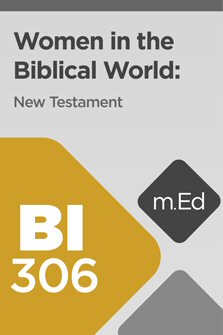
In Women in the Biblical World: New Testament, Dr. Mark Chavalas provides a historical survey of the status of women in the Graeco-Roman world, from the advent of alphabetic texts in the eastern Mediterranean and Aegean regions during the late eighth century BC, to the first century AD. He looks at Greek and Roman documents as well as classical-period documents from Egypt and other regions of the Near East. Dr. Chavalas presents a rich historical context for understanding how women were treated in the New Testament, and closes the course by evaluating many of the New Testament passages concerning women.
Contents:
Introduction
- Introducing the Speaker and the Course
- Unit 1: Male Depictions of Women
Introduction: The Classical World
- The Ideal Classical Male: Virtus
- The Ideal Classical Male: Horatio as an Example
- The Ideal Classical Female: Lucretia’s Story; a Snake in the Palace
- The Ideal Classical Female: Lucretia Dishonored
- The Ideal Classical Female: Lucretia’s Story; A Suicide Sparks a Revolution
- A Female Poet: Sappho
- Women in Homer
- Women in Hesiod: The Origin of Women
- Women in Hesiod: How to Pick a Wife
Unit 2: Depictions of Women by Philosophers and Physicians
- Greek and Roman Inscriptions and Funerary Texts
- Women and Philosophers: Aristotle, Men Are to Rule
- Women and Philosophers: Aristotle, Biological Basis of Male Superiority
- Women and Philosophers: Plato
- Women and Physicians: Galen
- Women and Physicians: Hippocrates
- A Case Study on Diagnosing the Cause of a Woman’s Insomnia
Unit 3: Women in Greek and Roman Law
- References to Women in Greek Law: The Murder of Eratosthenes
- References to Women in Greek Law: Euphiletus’ Defense at Trial
- Women in Roman Law: Laws Attributed to Romulus
- Women in Roman Law: The Twelve Tables
- Women in Roman Law: Husband’s Punishment of Wives in Early Rome
- Women in Roman Law: Aulus Gellius
- Women as Philosophers: Phintys
- Women in Philosophy: Hipparchia
Unit 4: Women in Classical Graeco-Roman Society
- Woman and Marriage: Plutarch, Marriage Advice, Part 1
- Woman and Marriage: Plutarch, Marriage Advice, Part 2
- Women and the Home: A Socratic Dialogue
- Women and the Home: The Husband Trains the Wife
- Women and the Home: Division of Labor Based on Perceived Gender Characteristics
- Women and the Home: Natural Appearance
- Women in Religion: Selection of Vestal Virgins
- Women in Religion: Service of Vestal Virgins
- Women and Drinking
- Women in Drama: Greek Dramatists
- Women in Drama: Euripides’ Medea
- Women in Comedy: Lysistrata, A Plan to End the War
- Women in Comedy: Lysistrata, Standoff at the Acropolis
- Women in Comedy: Lysistrata, Resolution and Reconciliation
- Women in Comedy: Thesmophoriazusae
- Reflections on Women in Classical Graeco-Roman Society
Unit 5: Women in Hellenistic and Roman Egypt
- Introduction to Women in Greek and Roman Egypt
- Women in Egypt according to Classical Sources
- Women and Mystery Religions: Funeral Arrangements
- Women and Mystery Religions: Worker Guilds; Associations
- Women and Mystery Religions: Proof of Devotion; Mystery
- Women, Oracles, and Spells: Procedures
- Women, Oracles, and Spells: An Example
- Women and the Gnostic Gospels
- Women and Petitions: Birth Registration; Injured Servant
- Women and Petitions: Defrauded of Her Inheritance
- Family Archives
- Paniskos/Ploutogenia, Personal Letters: Paniskos to Ploutogenia
- Paniskos/Ploutogenia, Personal Letters: Paniskos Confronts Ploutogenia
- Paniskos/Ploutogenia, Personal Letters: Ploutogenia to Her Mother
- Women and Marriage Contracts
- Widow Asks for a Guardian
- Husband Deserts Wife
- Woman Scalded by Bath Attendant
- Wife Deserts Husband and Child
- Father Wants to End Daughter’s Marriage
- Violent Husbands
- Women and Charms: An Odd Marriage Agreement
Unit 6: Women in the Jewish Tradition
- Women in the Wisdom of Sirach: Women, Wives
- Women in the Wisdom of Sirach: Wives, Daughters
- Women and the Temple
- Women and the Talmud, Part 1
- Women and the Talmud, Part 2
- Women in Judaism: Non-Rabbinic Texts on Daily Life
- Women in Judaism, Babatha: Marriage Contract and Loan Document
- Women in Judaism, Babatha: Lawsuits
- Women and the Synagogue and Early Church
Unit 7: Women in the Gospels
- Galatians 3:28: What’s Paul’s Point?
- Different Gospels; Different Audiences
- Social Context of Jesus: From the Wrong Side of the Tracks
- Social Context of Jesus: Reputedly Illegitimate
- Social Context of Jesus: Associated with Sinners
- Women in Matthew: Adultery and Divorce
- Women in Mark: Woman with an Issue of Blood
- Mark: The Syrophoenician Woman
- Matthew: The Canaanite Woman
- The Sinful Woman in Luke, Part 1
- The Sinful Woman in Luke, Part 2
- John 4, The Samaritan Woman: A Scandalous Encounter
- John 4, The Samaritan Woman: Some Samaritans Come to Faith
- John 8: The Adulterous Woman
Unit 8: Women in New Testament Epistles
- Introducing Women in the Pauline Epistles
- Women in 1 Corinthians 7: Celibacy and Monogamy
- Women in 1 Corinthians 7: Mutuality in Marriage; Singleness Also Good
- Women in 1 Corinthians 7: Marriage and Divorce
- Ethics: Classical and Biblical
- Women in 1 Corinthians 11: Headship Based on Chronology
- Women in 1 Corinthians 11: Literal and Figurative Uses of Head
- Women in 1 Corinthians 11: Head Coverings
- Women in 1 Timothy 2: Adorn Yourself with Character
- Women in 1 Timothy 2: Teaching and Authority
- Women in Titus
- Women in 1 Corinthians 14
- Women in Ephesians 5: “Be Subject” Means “Voluntary Submission”
- Women in Ephesians 5: “One Flesh” Provides the Rationale
- Women in 1 Peter 3
Conclusion
- Restoring the Status of Women
Dr. Chevalas is author or coauthor of publications including Mesopotamia and the Bible (Baker, 2002) and the IVP Bible Background Commentary: Old Testament (InterVarsity Press, 2000) and coeditor of The Ancient Near East and Women in the Ancient Near East. Dr. Chavalas has had fellowships at Yale, Harvard, Cornell, and other universities. He has nine seasons of excavation experience at various Bronze Age sites in Syria, and he is currently President of the American Oriental Society Middle West region and a member of the editorial board of the Bulletin of the American Schools of Oriental Research.
His research over the past decade has focused on interconnections between ancient Mesopotamia and outlying areas such as Anatolia, Iran, Egypt, and Syro-Palestine. Other recent research has investigated gender constructs in the ancient Near East and Mesopotamian historiography. Dr. Chavalas’ current research is focused on writing a history of Bronze Age Syria from the advent of writing in the third millennium BC to the Iron Age. His courses cover a wide area, including ancient Mesopotamia, Egypt, Israel, Syria, and Turkey; Iran before Islam; women in the ancient world; and the Akkadian and Sumerian languages.









